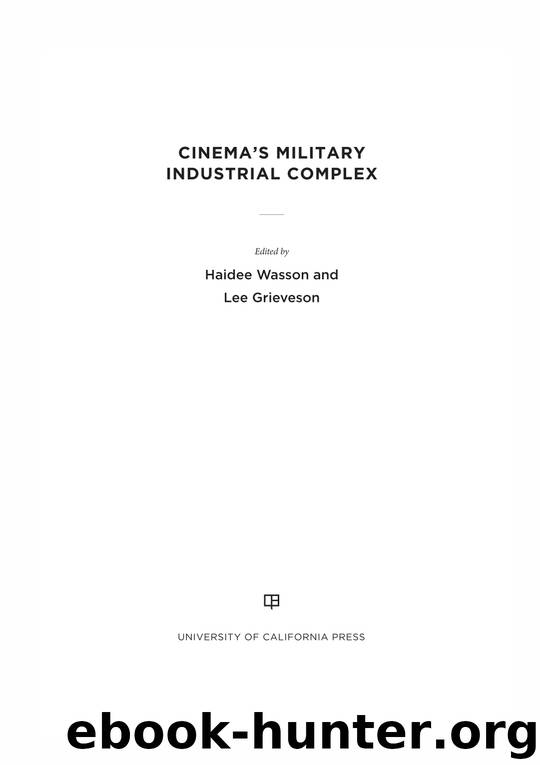Cinema's Military Industrial Complex by Haidee Wasson & Lee Grieveson

Author:Haidee Wasson & Lee Grieveson [Wasson, Haidee & Grieveson, Lee]
Language: eng
Format: epub
Tags: Performing Arts, Film, Genres, Documentary, History & Criticism, Historical, History, Military, United States, Political Science, Propaganda
ISBN: 9780520965263
Google: fHpFDwAAQBAJ
Publisher: Univ of California Press
Published: 2018-01-19T00:51:28.613000+00:00
PUBLICIZING MILITARY-INDUSTRIAL TRAINING
One of the most salient features of the wartime military film was its shifting, sometimes incompatible itineraries, which reflected the military’s belief that cinema could be useful as a source of instruction on both an ad hoc and an enduring basis. For instance, John Ford’s signal corps documentary Sex Hygiene (1941), produced in collaboration with the Office of the Surgeon General and the Research Council of the Academy of Motion Picture Arts and Sciences, remained in institutional circulation for three decades. Neither disposable instruments nor treasured works of art, wartime military films are prime examples of the functionality and durability of “useful cinema”—the filmic tools through which the military advanced an institutionally convenient conception of documentary at a time of widespread mobilization. As Jonathan Kahana argues, state documentary “addresses its viewers as citizens,” inviting them “to recognize that by interpreting the documentary text, or code, they take part in an ideal form of national community”8 For its part, the military-sponsored nonfiction film—a particular type of state documentary that, for the duration of the war, became the dominant form of government film production in the United States—sought to position its spectators as diverse “war workers,” situating them in terms of the following, often overlapping categories: soldiers, private arms manufacturers, and civilians capable (at the very least) of purchasing war bonds at their local movie theaters. In the 1940s, the military documentary became a means of soliciting broad spectatorial identification with the military itself—an ideological task that was hardly limited to wartime exigencies, and that troubles conventional accounts of state propaganda, which tend to reduce World War II training films to modest, temporary dimensions. Contrary to such accounts, these were, as the military itself maintained, “motion pictures of documentary importance.”9 Some were, to be sure, strictly utilitarian (such as short, step-by-step guides to lubricating machine guns), but even these were routinely reused by a range of filmmakers committed to the realist representation of the armed forces. They were also repurposed by the military itself, including on the army’s public-service television program The Big Picture, nearly a thousand episodes of which were produced between 1951 and 1971. Wartime military documentaries remained useful as more than just B-roll material, as The Big Picture’s regular practice of using footage from signal corps archives attests. The military’s nonfiction films, produced with the intent to train and educate, were also remediated to fulfill a number of seemingly unrelated aims. They entered union halls (such as those of the United Auto Workers) in order to foster a lasting sense of the connectedness of labor and military might. They also made their way into Rotary clubs in order to cultivate an appreciation for military intervention as a humanitarian affair.10
The military’s film program was predicated not only on a sense of the sheer utility of documentary as a fundamentally pedagogic enterprise, but also on the genre’s capacity to “honestly” promote identification with the military and its shifting goals. This included the use of footage shot to document war activities as much as to expressly teach or train.
Download
This site does not store any files on its server. We only index and link to content provided by other sites. Please contact the content providers to delete copyright contents if any and email us, we'll remove relevant links or contents immediately.
Call Me by Your Name by André Aciman(20348)
Ready Player One by Cline Ernest(14491)
How to Be a Bawse: A Guide to Conquering Life by Lilly Singh(7360)
Wiseguy by Nicholas Pileggi(5647)
The Kite Runner by Khaled Hosseini(5061)
On Writing A Memoir of the Craft by Stephen King(4847)
Audition by Ryu Murakami(4821)
The Crown by Robert Lacey(4710)
Call me by your name by Andre Aciman(4598)
Gerald's Game by Stephen King(4554)
Harry Potter and the Cursed Child: The Journey by Harry Potter Theatrical Productions(4427)
Dialogue by Robert McKee(4305)
The Perils of Being Moderately Famous by Soha Ali Khan(4156)
Dynamic Alignment Through Imagery by Eric Franklin(4096)
Apollo 8 by Jeffrey Kluger(3620)
Seriously... I'm Kidding by Ellen DeGeneres(3564)
The Inner Game of Tennis by W. Timothy Gallwey(3557)
How to be Champion: My Autobiography by Sarah Millican(3544)
Darker by E L James(3463)
